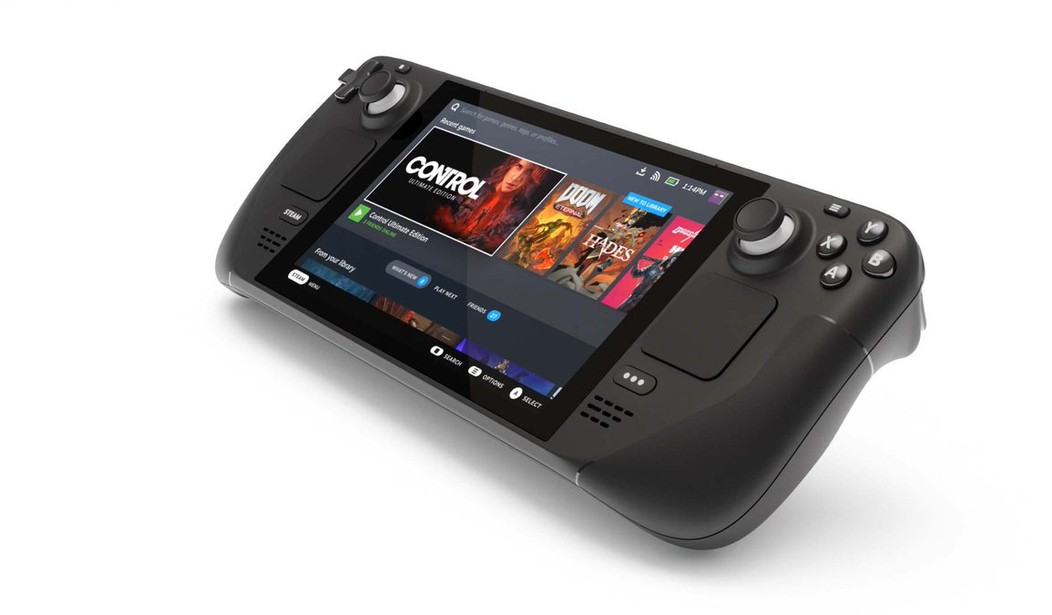I’ve mentioned a few times on the VIP Gold chats that while I was once the kind of guy who relentlessly kept up with the latest gadget and game trends, I tend not to do that now. More than a decade of smartphones, 12+ generations of the iPhone, five (at least, depending on the brand) generations of consoles, a gazillion mostly empty promises that this or that new thing is a “game-changer,” and more of Intel’s i-generation processors than a human brain can actually process enough to keep straight, will conspire to wane one’s interest. The PS5 is probably not in my future, but I do work using gaming PCs and do generally keep up with gaming as a thing I enjoy because I like having raw, savage, digital power at my fingertips.
The Steam Deck could be one of those things that promise to be a game-changer and actually is. It’s Valve’s entry into handheld gaming, a province that’s currently dominated by smartphones at the low end and the Nintendo Switch at the other end. The Aya Neo is a newish player in handheld, and others including NVidia have tried, but mostly failed.
The Steam Deck could change everything, though, because its promised specs make it something we’ve not had before: a true gaming PC built into a handheld form factor.
If you have questions about the Steam Deck reservation process, including regional availability, there's a reservation FAQ at https://t.co/6Ln0KvIGlw
To learn more about Steam Deck, visit https://t.co/ZOTx3KUCVK
— Steam (@Steam) July 16, 2021
Valve has allowed some select testers and media to get their hands on engineering versions of the Deck over the past few days, as the company gets ready to put them on the market for real around the holiday season this year. Adam Savage’s Tested got a look, and also interviewed a Steam guy wearing a mask. Overall they seemed impressed and had a few suggestions.
Linus Tech Tips has the best and most comprehensive video I’ve seen so far, so here it is.
He’s impressed and it’s not hard to see why. The Deck can play AAA game titles at 1280×720 60fps on its 60Hz display butter smooth. The form factor seems to work extremely well. Its gyros add another layer to control for FPS games. Multi-player seems to work extremely well, even when playing against other true gaming desktop PCs. That makes sense because the Steam Deck is pretty much a gaming laptop crammed into that small handheld console.
Steam is doing a lot of smart things here, it seems. The Steam library is massive, at over 10,000 titles released in 2020 alone including everything from retro and old-school stuff to the very latest. The Fallout library is there in its entirety, EA’s library is there, CSGO, just about everything big but also thousands of indie and free-to-play titles are there too. Steam’s library dwarfs Ninendo’s library for the Switch handhelds. It’s just massive. By building this platform, Steam can get players, from the novice to the hardcore, hooked into its ecosystem where they can mainline nearly every new mainstream title, for the life of the Deck. Then Valve can start to get away from Windows if it wants or needs to.
Under the hood, the Steam Deck is powerful enough to run full Windows 10 (and presumably 11, which comes out around the same time the Deck is supposed to). It’s not installed with Win 10, rather, it’s running its own Linux-based OS with an emulator to run the games that the Windows-based Steam library lives on. That sounds like a serious glitch factory, but it seems to work well in the hands-on tests thus far. The Deck has a touchscreen, WiFi, Bluetooth, and USB-C connections. All of this means you can install Windows on it if you want, as a side-load, either on the on-board SSD or NVMe drive (in the two higher-priced versions of the Deck) or the MicroSD slot. Then, the Steam Deck becomes a true portable gaming laptop that you can also connect to a mouse, keyboard, or external monitor(s).
That’s…nuts. Bonkers. And possibly a game-changer well beyond the mere playing of games.
Recommended: Carli Lloyd Stands Alone
On the usability and sales strategy side, lots of observers are warning gamers away from the base model of the Deck as it seems to have been built to generate positive headlines about a low price point. I won’t argue with that. It’s cheap, at $399 for a beast of a machine, but it also only comes with a 64GB SSD. That’s tiny for running today’s high-end games and even Windows itself, and might be a tad slow for the top games as well. The next step up lands you a 256GB NVMe drive, which is obviously more space but also a lot more speed. The next step up gets you a bigger NVMe drive and better, less glare-prone glass.
But if you only buy the entry-level Deck to, say, run some of the lower-end games while using it to, say, power your mobile or home office the rest of the time, $399 ain’t bad. It’s going to be faster than that “business class” laptop you’re using now and not a lot more expensive than the mini-PC you’ve had your eye on. The mini-PC probably has more ports to connect more things, but that’s what hubs are for (and the Steam Deck has a dock on the way). The Steam Deck is going to be hacked and modded to do lots of things it’s not designed to do out of the box because it’s packed with lots of power inside and even the most expensive model isn’t insanely expensive, not for a full-fledged gaming laptop that happens to be packed into a different form factor.
But that’s all speculative. There’s no bottom line yet because the Deck hasn’t officially hit the market and nobody has had the opportunity to hack it, open it up and install some monster drive, make it run their smart home, or any of that. It does look like it could do to the handheld market what the iPad did to tablet computing, namely, really put it on the map for serious use. The Switch, while cool, hasn’t really done that in my opinion. It’s seen as mostly for less hardcore gamers, kids, and so forth, in the same way that the Wii and DS were. Nice and novel but not bleeding edge powerful. That’s been part of Nintendo’s MO — use less powerful hardware wrapped in a new way to game and its own mostly closed ecosystem. The drawback is those consoles sport last-gen power from their day of debut so they look dated from day one.
This will not be the case with the Steam Deck. It will look superior to the Switch because it’s more powerful, and will play top-level games at high-quality settings at 60fps out of the box. It will look better than the majority of systems many gamers use right now. Plus it can do a whole lot more than play games.









Join the conversation as a VIP Member